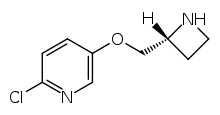Tebanicline
Tebanicline (Ebanicline, ABT-594) is a potent synthetic nicotinic (non-opioid) analgesic drug developed by Abbott. It was developed as a less toxic analogue of the potent poison dart frog-derived compound epibatidine, which is some 200x stronger than morphine as an analgesic but produces extremely dangerous toxic side effects.[1][2] Like epibatidine, tebanicline showed potent analgesic activity against neuropathic pain in both animal and human trials, but with far less toxicity than its parent compound.[3][4][5][6][7][8] It acts as a partial agonist at neuronal nicotinic acetylcholine receptors, binding to both the α3β4 and the α4β2 subtypes.[9]
 | |
| Clinical data | |
|---|---|
| ATC code |
|
| Identifiers | |
IUPAC name
| |
| CAS Number | |
| PubChem CID | |
| IUPHAR/BPS | |
| ChemSpider | |
| UNII | |
| ChEMBL | |
| ECHA InfoCard | 100.207.679 |
| Chemical and physical data | |
| Formula | C9H11ClN2O |
| Molar mass | 198.65 g·mol−1 |
| 3D model (JSmol) | |
SMILES
| |
InChI
| |
| | |
Tebanicline got as far as Phase II trials in humans,[10] but was dropped from further development due to unacceptable incidence of gastrointestinal side effects.[11] However further research in this area is ongoing,[12][13][14][15] and it was widely expected that development of new neural nicotinic acetylcholine receptor agonists would be likely to lead to novel analgesics suitable for use in humans within the next few years.[16][17][18][19] In practice however, no agents from this class have made it the whole way through human clinical trials due to their unacceptable side effect profile, though they continue to hold theoretical promise and research in the area continues.[20]
References
- Bannon AW, Decker MW, Holladay MW, Curzon P, Donnelly-Roberts D, Puttfarcken PS, et al. (January 1998). "Broad-spectrum, non-opioid analgesic activity by selective modulation of neuronal nicotinic acetylcholine receptors". Science. 279 (5347): 77–81. doi:10.1126/science.279.5347.77. PMID 9417028.
- Holladay MW, Wasicak JT, Lin NH, He Y, Ryther KB, Bannon AW, et al. (February 1998). "Identification and initial structure-activity relationships of (R)-5-(2-azetidinylmethoxy)-2-chloropyridine (ABT-594), a potent, orally active, non-opiate analgesic agent acting via neuronal nicotinic acetylcholine receptors". Journal of Medicinal Chemistry. 41 (4): 407–12. doi:10.1021/jm9706224. PMID 9484491.
- Donnelly-Roberts DL, Puttfarcken PS, Kuntzweiler TA, Briggs CA, Anderson DJ, Campbell JE, et al. (May 1998). "ABT-594 [(R)-5-(2-azetidinylmethoxy)-2-chloropyridine]: a novel, orally effective analgesic acting via neuronal nicotinic acetylcholine receptors: I. In vitro characterization". The Journal of Pharmacology and Experimental Therapeutics. 285 (2): 777–86. PMID 9580626.
- Bannon AW, Decker MW, Curzon P, Buckley MJ, Kim DJ, Radek RJ, et al. (May 1998). "ABT-594 [(R)-5-(2-azetidinylmethoxy)-2-chloropyridine]: a novel, orally effective antinociceptive agent acting via neuronal nicotinic acetylcholine receptors: II. In vivo characterization". The Journal of Pharmacology and Experimental Therapeutics. 285 (2): 787–94. PMID 9580627.
- Decker MW, Bannon AW, Buckley MJ, Kim DJ, Holladay MW, Ryther KB, et al. (April 1998). "Antinociceptive effects of the novel neuronal nicotinic acetylcholine receptor agonist, ABT-594, in mice". European Journal of Pharmacology. 346 (1): 23–33. doi:10.1016/S0014-2999(98)00042-9. PMID 9617748.
- Kesingland AC, Gentry CT, Panesar MS, Bowes MA, Vernier JM, Cube R, et al. (May 2000). "Analgesic profile of the nicotinic acetylcholine receptor agonists, (+)-epibatidine and ABT-594 in models of persistent inflammatory and neuropathic pain". Pain. 86 (1–2): 113–8. doi:10.1016/s0304-3959(00)00233-5. PMID 10779668.
- Sorbera, L.A.; Revel, L.; Leeson, P.; Castañer, J. (2001). "ABT-594". Drugs of the Future. 26 (10): 927. doi:10.1358/dof.2001.026.10.640317.
- Lynch JJ, Wade CL, Mikusa JP, Decker MW, Honore P (February 2005). "ABT-594 (a nicotinic acetylcholine agonist): anti-allodynia in a rat chemotherapy-induced pain model". European Journal of Pharmacology. 509 (1): 43–8. doi:10.1016/j.ejphar.2004.12.034. PMID 15713428.
- Jain KK (January 2004). "Modulators of nicotinic acetylcholine receptors as analgesics". Current Opinion in Investigational Drugs. 5 (1): 76–81. PMID 14983978.
- Decker MW, Meyer MD, Sullivan JP (October 2001). "The therapeutic potential of nicotinic acetylcholine receptor agonists for pain control". Expert Opinion on Investigational Drugs. 10 (10): 1819–30. doi:10.1517/13543784.10.10.1819. PMID 11772288.
- Meyer, Michael D. (1 April 2006). "Neuronal nicotinic acetylcholine receptors as a target for the treatment of neuropathic pain". Drug Development Research. 67 (4): 355–359. doi:10.1002/ddr.20099. ISSN 1098-2299.
- Baraznenok IL, Jonsson E, Claesson A (March 2005). "3-(2,5-Dihydro-1H-pyrrol-2-ylmethoxy)pyridines: synthesis and analgesic activity". Bioorganic & Medicinal Chemistry Letters. 15 (6): 1637–40. doi:10.1016/j.bmcl.2005.01.058. PMID 15745813.
- Zhang CX, Ge ZM, Cheng TM, Li RT (April 2006). "Synthesis and analgesic activity of secondary amine analogues of pyridylmethylamine and positional isomeric analogues of ABT-594". Bioorganic & Medicinal Chemistry Letters. 16 (7): 2013–6. doi:10.1016/j.bmcl.2005.12.073. PMID 16412637.
- Bunnelle WH, Daanen JF, Ryther KB, Schrimpf MR, Dart MJ, Gelain A, et al. (July 2007). "Structure-activity studies and analgesic efficacy of N-(3-pyridinyl)-bridged bicyclic diamines, exceptionally potent agonists at nicotinic acetylcholine receptors". Journal of Medicinal Chemistry. 50 (15): 3627–44. doi:10.1021/jm070018l. PMID 17585748.
- Joshi SK, Mikusa JP, Weaver B, Honore P (February 2008). "Morphine and ABT-594 (a nicotinic acetylcholine agonist) exert centrally mediated antinociception in the rat cyclophosphamide cystitis model of visceral pain". The Journal of Pain. 9 (2): 146–56. doi:10.1016/j.jpain.2007.09.004. PMID 18088559.
- Lloyd, GK; Williams, M (2000). "Neuronal Nicotinic Acetylcholine Receptors as Novel Drug Targets". Journal of Pharmacology and Experimental Therapeutics. 292: 461–467.
- Vincler M (October 2005). "Neuronal nicotinic receptors as targets for novel analgesics". Expert Opinion on Investigational Drugs. 14 (10): 1191–8. doi:10.1517/13543784.14.10.1191. PMID 16185161.
- Arneric SP, Holladay M, Williams M (October 2007). "Neuronal nicotinic receptors: a perspective on two decades of drug discovery research". Biochemical Pharmacology. Nicotinic Acetylcholine Receptors as Therapeutic Targets: Emerging Frontiers in Basic Research and Clinical Science. 74 (8): 1092–101. doi:10.1016/j.bcp.2007.06.033. PMID 17662959.
- Wells GB (May 2008). "Structural answers and persistent questions about how nicotinic receptors work". Frontiers in Bioscience. 13 (13): 5479–510. doi:10.2741/3094. PMC 2430769. PMID 18508600.
- Umana IC, Daniele CA, McGehee DS. Neuronal nicotinic receptors as analgesic targets: it's a winding road. Biochem Pharmacol. 2013 Oct 15;86(8):1208-14. doi: 10.1016/j.bcp.2013.08.001 PMID 23948066